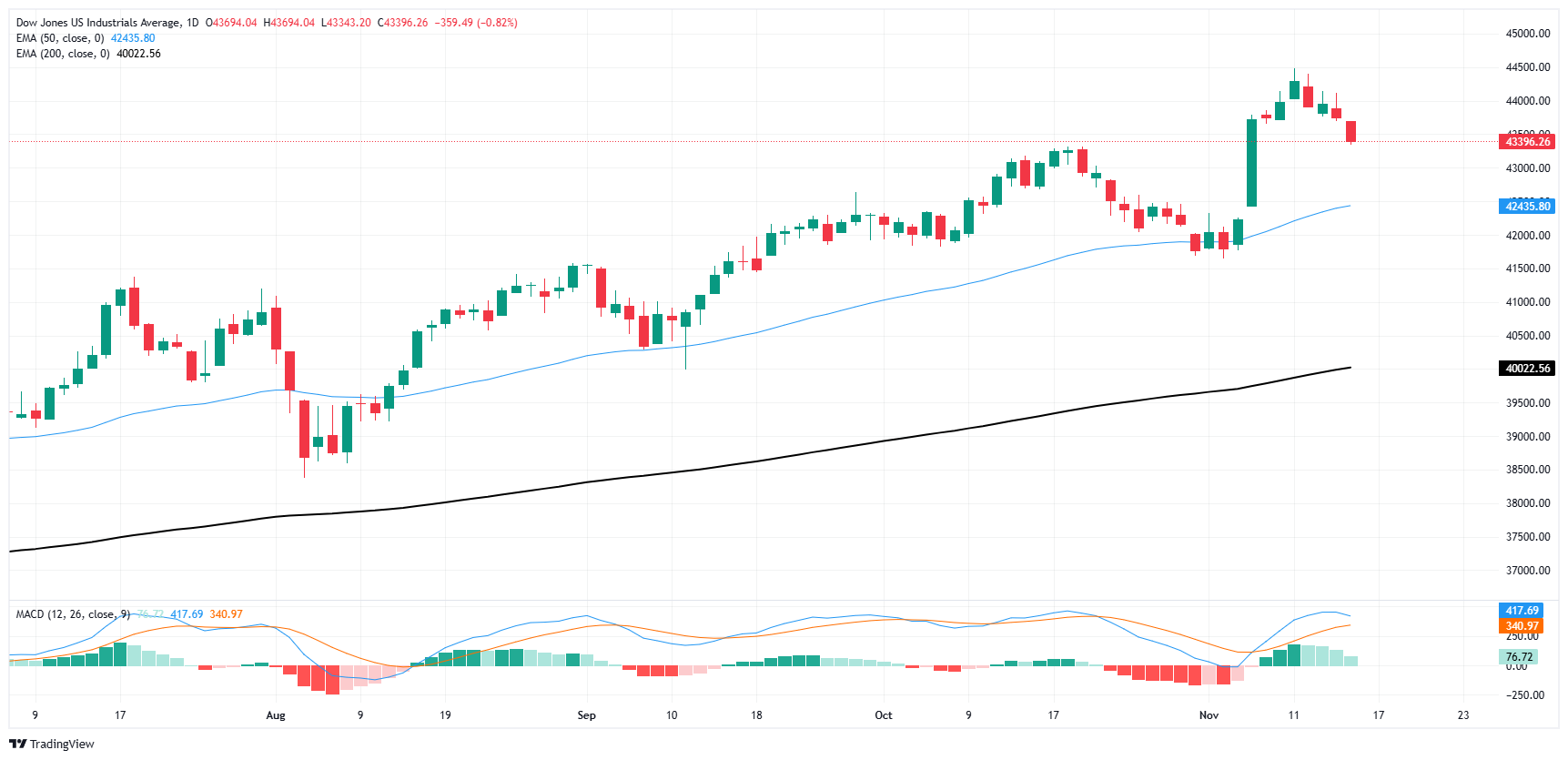Dow Jones Industrial Average tumbles over 350 points on Friday
- The Dow Jones fell over three-quarters of a percent on Friday.
- Stocks are paring back recent election-fueled gains.
- US Retail Sales beat forecasts, but still grew by a smaller amount in October.
The Dow Jones Industrial Average (DJIA) trimmed it’s recent bull run, declining over 350 points and giving back roughly 0.85% as investors grapple with an increasingly uncertain future. US Retail Sales beat expectations but still eased back from previous figures, and Federal Reserve (Fed) Chair Jerome Powell splashed cold water on rate-cut-hungry investors this week when he reaffirmed that the Fed wasn’t “in a hurry” to cut interest rates further.
The post-election “Trump rally” is set to continue unwinding as the Trump campaign begins to leak potential candidates for key official positions that former President Donald Trump intends to install at the beginning of his second term in January. Pharmaceutical stocks took an unexpected hit on Friday after Trump’s team announced their plans to nominate vaccine skeptic Robert F. Kennedy Jr. to the head of the US Department of Health and Human Services. RFK Jr. has openly discussed his plans to ban several vaccines and other health products outright, a surprisingly hyper-regulatory move that flies in the face of the broader market’s initial exuberance at a Trump election win which was meant to carry further deregulation efforts to the public marketplace.
US Retail Sales grew by 0.4% MoM in October, slightly above the 0.3% forecast but still down from September’s revised print of 0.8%. Core Retail Sales, or Retail Sales excluding automobile purchases, failed to meet expectations, growing by a scant 0.1% compared to the expected 0.3% and even further below the previous month’s 1.0% revised print.
Dow Jones news
Despite steep headline losses in key equities, the Dow Jones is roughly on-balance on Friday, with about half of the major equity board’s listed stocks finding the green for the day. Disney (DIS) rose another 5.3% to $115 per share as the entertainment giant enjoys a firmer rebound in quarterly revenues than many investors anticipated. Meanwhile, Amazon (AMZN) and Amgen (AMGN) both fell around 4.5% on the day to $201 and $282 per share, respectively, as tech stocks and biomed stocks take an end-of-week hit.
Dow Jones price forecast
Despite a bearish extension on Friday sending the Dow Jones deeper into the red for the week, there’s still plenty of room to run to the downside before technical warnings begin to emerge. Bullish pressure could also reappear in the charts at anytime as investors remain hopeful to keep a firm grasp on record high territory.
The Dow Jones is poised to end the week lower by 1.3% despite setting an other new all-time high bid earlier this week at 44,485. The nearest technical barrier sits at the 50-day Exponential Moving Average (EMA) near 42,430.
Dow Jones daily chart
Dow Jones FAQs
The Dow Jones Industrial Average, one of the oldest stock market indices in the world, is compiled of the 30 most traded stocks in the US. The index is price-weighted rather than weighted by capitalization. It is calculated by summing the prices of the constituent stocks and dividing them by a factor, currently 0.152. The index was founded by Charles Dow, who also founded the Wall Street Journal. In later years it has been criticized for not being broadly representative enough because it only tracks 30 conglomerates, unlike broader indices such as the S&P 500.
Many different factors drive the Dow Jones Industrial Average (DJIA). The aggregate performance of the component companies revealed in quarterly company earnings reports is the main one. US and global macroeconomic data also contributes as it impacts on investor sentiment. The level of interest rates, set by the Federal Reserve (Fed), also influences the DJIA as it affects the cost of credit, on which many corporations are heavily reliant. Therefore, inflation can be a major driver as well as other metrics which impact the Fed decisions.
Dow Theory is a method for identifying the primary trend of the stock market developed by Charles Dow. A key step is to compare the direction of the Dow Jones Industrial Average (DJIA) and the Dow Jones Transportation Average (DJTA) and only follow trends where both are moving in the same direction. Volume is a confirmatory criteria. The theory uses elements of peak and trough analysis. Dow’s theory posits three trend phases: accumulation, when smart money starts buying or selling; public participation, when the wider public joins in; and distribution, when the smart money exits.
There are a number of ways to trade the DJIA. One is to use ETFs which allow investors to trade the DJIA as a single security, rather than having to buy shares in all 30 constituent companies. A leading example is the SPDR Dow Jones Industrial Average ETF (DIA). DJIA futures contracts enable traders to speculate on the future value of the index and Options provide the right, but not the obligation, to buy or sell the index at a predetermined price in the future. Mutual funds enable investors to buy a share of a diversified portfolio of DJIA stocks thus providing exposure to the overall index.

